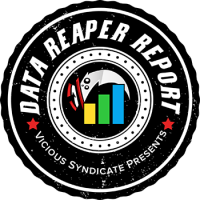
Welcome to the 45th edition of the Data Reaper Report!
Our Data Reaper Project, including the Data Reaper Live (Beta) has over 2,600 active contributors. Without them, this project would not be possible, so we’d like to thank all of our contributors for their help.
Quick Links
Class/Archetype Distribution | Class Frequency | Matchup Winrates | vS Power Rankings | Class Analysis & Decklists | Meta Breaker of the Week | How to Contribute | Credits
Number of Games
| Overall | 104,000 |
| Legend | 20,500 |
| Ranks 1-5 | 46,000 |
| Ranks 6-10 | 18,000 |
| Ranks 11-15 | 8,000 |
Class/Archetype Distribution
Class Frequency by Day
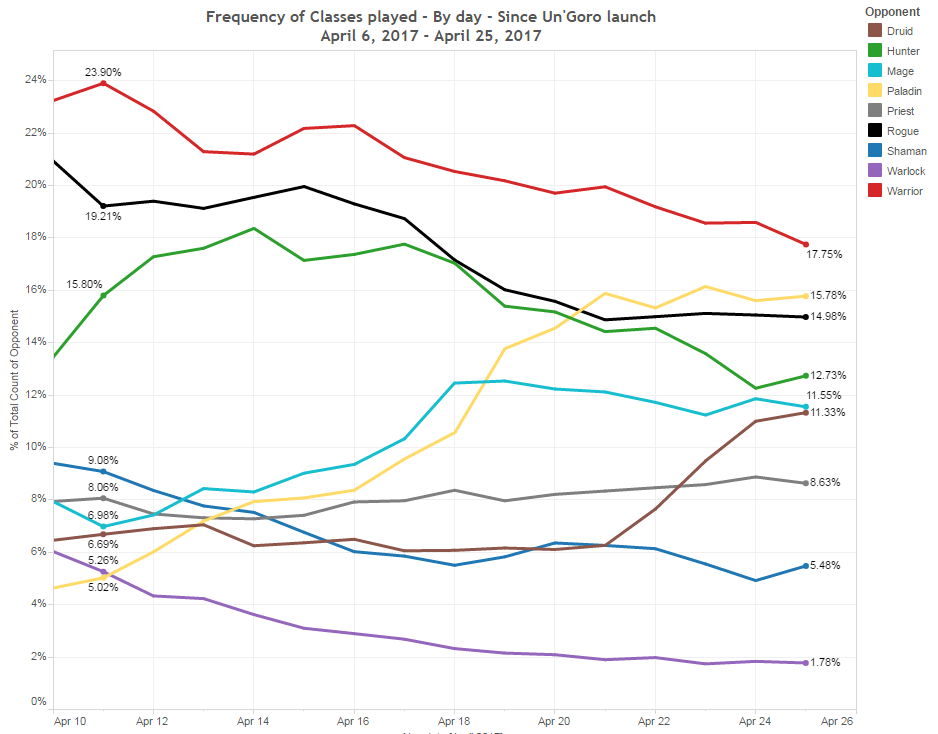 Class Frequency by Week
Class Frequency by Week
 The Paladin class has skyrocketed over the past week in its representation share of the Meta. At legend, it is the most popular class in the game, overthrowing Warrior and Rogue. This is on the back of the discovery that Murloc-based Paladin decks were Meta breakers waiting to happen. The aggressive Murloc Paladin is more popular than its Midrange counterpart. The difference between the two archetypes is that Murloc Paladin fully commits to the tribal synergy and forgoes some of the late game and defensive tools available to the class, while Midrange Paladin has a more modest Murloc package and utilizes it mostly to have a strong opener, as well as leveraging it during the late game by translating its hero power into value with Megasaur and Warleader swing turns. Paladin doesn’t stop at two archetypes, as Control Paladin has also surged into decent ladder representation over the past week, with several different approaches being observed. Paladin has developed into a very versatile class in the Un’Goro Meta, reminiscent of the Warrior class during Whispers of the Old Gods.
The Paladin class has skyrocketed over the past week in its representation share of the Meta. At legend, it is the most popular class in the game, overthrowing Warrior and Rogue. This is on the back of the discovery that Murloc-based Paladin decks were Meta breakers waiting to happen. The aggressive Murloc Paladin is more popular than its Midrange counterpart. The difference between the two archetypes is that Murloc Paladin fully commits to the tribal synergy and forgoes some of the late game and defensive tools available to the class, while Midrange Paladin has a more modest Murloc package and utilizes it mostly to have a strong opener, as well as leveraging it during the late game by translating its hero power into value with Megasaur and Warleader swing turns. Paladin doesn’t stop at two archetypes, as Control Paladin has also surged into decent ladder representation over the past week, with several different approaches being observed. Paladin has developed into a very versatile class in the Un’Goro Meta, reminiscent of the Warrior class during Whispers of the Old Gods.
Another class that has seen a significant rise in play is Mage, and during the process, it has completely turned upside down. PsyGuenther’s Discover Mage has taken over, and we have re-labeled it as the new “Burn” Mage, while the all-in aggressive variants have completely fizzled out due to the new build having similar advantages of strong early starts into direct damage follow ups, but also having the ability to fall back into a value oriented plan. In order to best represent the power levels of this archetype, we reset all matchup data concerning it before the PsyGuenther build appeared. We hope it isn’t too confusing since we were associating the name with more aggressive builds last week, but this can happen in a Meta that is very young. Why not call it “Control Mage”? When you analyze its patterns of play, it’s actually exhibiting the behavior of a deck that is quite aggressive and damage centric. Even though it has some tools that are definitely ‘control’ oriented, it acts as the “beatdown” in a large percentage of matchups, so we felt it was a bit strange to call it a control deck. Besides that, we like the flavor of having a “Burn” and “Freeze” archetypes better!
As Paladins and Mages rise, Warriors and Rogues fall. These two classes were the frontrunners of the Meta, exhibiting their powerful tools in the early days and attracting much attention. However, the Meta has caught up, and while these classes are very strong, they are not dominant enough to justify their previous representation, so they’re falling back to Earth a bit. Pirate Warrior’s numbers have remained steady, but Taunt Warrior has significantly declined at all levels of play, especially at legend where its numbers dropped by over 30%. This is likely a result of the rise of Paladins, which pose a difficult challenge for the archetype, especially the Midrange kind. Both Crystal Rogue and Miracle Rogue have declined at all levels of play, with the Meta adapting and focusing its anger at Rogue since the class exploded during the early days of Un’Goro.
Another class that’s declining is Hunter. The class remains very popular at lower levels of play, but seems to be hitting a wall when it comes to its representation at legend, which is a hint towards a skill wall being hit as well. Even so, Hunter is in a much, much better spot in the Meta than during the dark days of Gadgetzan, when it wasn’t even relevant. The class seems to be a “Steady Eddie”. Reliable, flexible, and a good choice for new players, while not being spectacular.
Druid is enjoying a surge in popularity on the back of great individual success with the class at the top end of the legend latter. Token Druid has seen an increase in play at all levels, especially at legend, and is an attractive choice due to its good matchups against other aggressive decks, as well as the completely and utterly dominant matchup it has against the most hated deck in the game currently, Crystal Rogue. Jade Druid has returned from its slumber as well, with a modified build enjoying success at high levels of play, just as long as it doesn’t meet Rogue. It seems to have carved out a niche in the Un’Goro Meta, despite looking very weak early on.
Priest is in a bit of a mess. It’s playing around with a lot of cool stuff, but that hasn’t really translated into solid, consistent builds (with the exception of Dragon Priest). There is a lot of experimentation, especially with Lyra-based Miracle Priest decks, but unlike other classes where we see a clear convergence into defined structures, Anduin is still mostly fooling around. Is Priest hard to figure out, or are things just not working out for Priest on ladder which could explain this erratic behavior?
Shaman’s numbers are continuing to crash, as the class is settling into a very niche role far away from where it was during the Year of the Kraken. However, we think the class still has something to say about the Meta, since many of its potential archetypes are relatively unexplored. Elemental Shaman maintains strong matchups against aggressive decks, but really struggles too much against Taunt Warrior and Crystal Rogue to be able to establish a stronger ladder presence at the moment. Control Shaman is beginning to emerge on the back of some experimentation, while Aggro Shaman is also out there in a different form. Rather than relying on power minions and direct damage, it is now a token focused archetype that aggressively floods the board and finishes games with Bloodlust.
If we take a glance at a Meta at the legend ranks, we definitely see a lot of positives to take from the current situation. The Meta is currently extremely diverse. There is no class with over 20% representation. There is no archetype that even passes 10% representation. Nearly every class has multiple archetypes seeing play with different playstyles. Is this a temporary honeymoon period due to the Meta still being young? Are we going to see a “tyrant” taking over soon, or will this diversity last? We can say that from observing the Meta, there are still quite a few avenues being neglected and unexplored, and there is a very good chance some archetypes that barely see play at the moment, suddenly pop into the scene much like Murloc Paladin, so there is room for optimism that the long, stagnant, hair pulling period of Gadgetzan does not repeat itself.
Of course, we’re not talking about Warlock when we discuss this optimism. This class seems to be in a very bad shape that rivals what Paladin and Hunter have endured for the previous 4 months. Handlock needs recovery tools, while Zoo needs consistency.

Note: As we’ve said earlier, Burn Mage data has been reset to reflect the most recent builds, initially pioneered by PsyGuenther. We have also reset Jade Druid’s power ranking score, as the archetype has displayed significant differences in its performance levels across the field over the past week. We will continue to update and perfect our definition algorithm on a regular basis and adjust it for the changing Meta while striving for maximum accuracy. Output of the algorithm is, as always, displayed in our radar maps.
The first thing we can observe is a deflation in the overall win rates of most decks in the game. This is a result of poorly performing archetypes disappearing from the scene, as the Meta becomes much more competitive. Less “easy wins” are available, especially at higher levels of play, so there are several decks displaying high win rates. Remember that tiers are an abstract form of grouping up power levels. Decks of over 52% win rates are extremely strong. Decks that pass the 50% win rates are very good. Decks that are slightly below 50% win rate are also good decks which are viable and competitive; they are just not as inherently strong. Only decks that are some way below 50% are those that are truly struggling to find their footing in the Meta. Keep that in mind when drawing conclusions on a deck’s viability.
Pirate Warrior remains at the top at all levels of play, and the surge of Paladin seems to have been halted. The cause? The Meta has been teching aggressively against Paladin, especially at higher levels of play. We’ve seen Hungry Crabs running around in more than one class, which is an extremely debilitating tech cards against the Murloc based Paladin decks. However, Paladin remains very powerful despite the tech hate. When it comes to the different archetypes, Midrange Paladin is a stronger deck against the Warrior class, as it is much more resilient, so it performs better than the full Murloc aggressive builds outside of legend. At legend, there are less Taunt Warriors, and there are more mirror matchups, which gives the edge to the more aggressive Paladin archetype that holds an advantage in the mirror. Murloc Paladin is also a stronger deck against both Rogue archetypes, as it can mount pressure in the early game much more consistently. Taunt Warrior has definitely dropped off in power as a result of Paladin’s rise, so we’re not surprised it saw such a dramatic drop in play at legend rank. Meanwhile, Control Paladin seems to carry potential as a decent anti-aggro deck, but it doesn’t do very well in the mirror, and performs very poorly against Rogue.
After lowering its head a bit, Rogue is enjoying more room to breathe at higher levels of play with much of the attention being focused on Paladins. Miracle Rogue is one of the decks that welcomes the rise of Paladin with open arms. It has good matchups against slower Paladin decks, and even its matchup against the aggressive Murloc Paladin is a close affair. What really cripples Miracle Rogue is the combination of board flooding and burn, and the latter is not included in the Paladin’s kit. All of the heavy teching being done also greatly benefits Crystal Rogue, as it forces brutal efficiency from its opponents in order to kill it as quickly as possible. The archetype is also displaying a significantly better performance at higher levels of play, which pushes it over the 50% win rate mark at legend. Crystal Rogue is not going anywhere, and while it’s unlikely that it will dominate the Meta since it’s easy to target, it’s definitely shaping it by propagating aggression, as some of its matchups are ridiculously one-sided. “Rock, Paper, Scissors” may not be the most accurate way to describe the Meta, but what’s creating this feeling mostly stems from the experience of playing as, and against this deck.
There is good news and bad news for Mage. The good news is that the new “discover” Burn Mage builds are doing very well and the archetype is pretty powerful against the current field. The bad news is that Freeze Mage is quickly dropping in its viability. The reason stems from cannibalism. Both Mage archetypes carry Ice Blocks, but one has minion pressure and high value cards while the other has card draw and stall. This makes it a pretty lopsided and difficult affair for Freeze Mage. However, unlike the aggressive Mage decks that have had their niche swallowed, there are still many matchups in which Freeze Mage holds the advantage. This means that a change in the Meta could alter this dynamic in the future. More importantly, for the competitive scene, there is still merit to bring Freeze Mage to tournaments over Burn Mage in some line ups and situations. Meanwhile, Secret Mage continues to be a secret. While this archetype has a fairly low representation, it’s doing very well with it, and this has been consistent over quite some time. This is one of the decks we internally identified during the first week of Un’Goro as a possible undiscovered gem. Other ones that blew up since then were Freeze Mage, Murloc Paladin and Midrange Paladin. Not a bad company.
Token Druid’s numbers remain quite strong, though they have deflated much like most of the relatively established archetypes’ scores. The deck’s poor matchups are hard control, while it does very well against the rest of the Meta. Jade Druid meanwhile, has skyrocketed into Tier 3. Yes, it performed so poorly before that in order to reach the heights of a win rate that is slightly below 50%, it needed to skyrocket. Still though, we see the niche it’s establishing, which is not much different than what it was before the expansion: making life miserable for Taunt (Control) Warrior and Mage. The added life gain through Earthen Scale and the utility of Primordial Drake makes aggressive matchups more bearable than before too. The problem? Rogue. Jade Druid gets completely stomped on by Crystal Rogue in particular. Join the club.
Who’s already in the club? Priest. Things don’t look very good for Priest’s prospects on ladder. It’s failing to make its mark, and while the class is very fun to play, not winning games will eventually cause players to move away from it. Dragon Priest looks solid and unspectacular, while Silence Priest is seeing a few promising successful runs lately. Miracle Priest is still searching for a Miracle, throwing everything at the wall and hoping something sticks. Right now, it’s mostly sliding down the gutter.
Shaman is receiving a lot of flak and is being written off. We think it’s pretty premature to do so, since it’s showing quite a bit of potential. It’s evident that Elemental Shaman struggles at higher levels of play, where Rogues give it a lot of trouble, and the Taunt Warrior matchup is also crippling. However, it has really good matchups against aggressive decks. The builds are also mostly unexplored, and there are many way to build Elemental Shaman, so the archetype carries some value. More so, we think aggressive Shaman decks are being underestimated. While the old Aggro Shaman has died out, the token centric builds with Bloodlust are doing very well. Perhaps it is being overshadowed by Token Druid, which has a similar game plan, or it does well because it’s unexpected, but it still does well enough to merit a higher profile. As for Control Shaman, its score isn’t bad considering it’s very young in its development, so the jury is still out.
Warlock is being written off, and that might be correct. These win rates are worthy of some memes. Damn, is Warlock the meme class now?
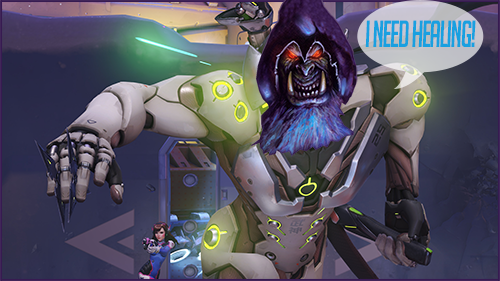
Class Analysis & Decklists
Druid | Hunter | Mage | Paladin | Priest | Rogue | Shaman | Warlock | Warrior
By the Holy Light! Paladin’s renaissance is in full force this week, as the Meta continues to shake itself out and archetypes become more refined. The big story this week is the rise of Murloc Paladin (the aggressive version), especially at legend ranks where it has one of the highest single representation of any archetype across any class.
Midrange Paladin is still performing well, and the lists we noticed last week remain relatively stable and untouched with one slight adjustment, which is the addition of Murloc Tidecaller as a second 1-drop in some builds in order to give the deck a more consistent early game and another target for Rockpool Hunter. This was the first archetype to gain high visibility and traction, but the more aggressive Murloc variant has an advantage in the mirror due to the ability to gain early board control with its faster curve. Adding Tidecaller gives Midrange Paladin a better chance to compete with its faster counterpart, and makes it slightly better in other matchups that require a faster opening, such as Crystal Rogue and Midrange Hunter. Thijs’ build is a good example of more recent iterations, and also includes a Hungry Crab in order to further improve the mirror matchup. Consider adding a second Equality and Ragnaros the Lightlord instead of the Crab and the Wickerflame if you’re encountering a slower Meta and fewer mirrors.
The other big winner this week is Control Paladin, which has seen some pretty exciting innovations due to the rise of aggro decks pushing out Crystal Rogue (among others). Bbgungun piloted a high-value N’Zoth build to top 10 legend, whereas Feno also had similar success with a non-N’Zoth build running a Curator package instead. The main benefit of the Control variants are better matchups against the aggressive decks on ladder compared to the murloc-based versions, while taking advantage of the dominating late-game power of the Paladin class legendaries in more grindy value-based matchups.
Paladin seems to be developing into an extremely versatile class that is well-situated in the current Meta and is likely to remain a force for the foreseeable future.
- Paladin Class Radar
- Thijs’ Midrange Paladin
- Machamp’s Midrange Paladin
- Tholwmenos’ Murloc Paladin
- Newton’s Murloc Paladin
- Bbgungun’s N’Zoth Control Paladin
- Feno’s Curator Control Paladin
With the Meta still in the process of settling down, Rogue is left with clear advantages and disadvantages. The greatest weakness of Rogue is its difficulty dealing with aggressive decks, due to its lack of board clears post Blade Flurry nerf, as well as healing. Even though Miracle Rogue has a plethora of powerful single target removal, the deck struggles to use its cheap spells and efficient hero power to stabilize against the aggression from decks that flood the board early and/or carry a lot of burst damage, such as Pirate Warrior and Token Druid.
One of the latest Miracle Rogue builds, with which Mage reached top 5 legend, cuts Arcane Giants and adds Leeroy back with Cold Bloods, to give the deck racing potential against aggressive decks, earlier kill potential against Crystal Rogue, and a better chance against Freeze Mage by circumventing its stall mechanics with burst from hand. The build also utilizes two SI Agents, which are particularly effective against Paladins as well as Hunters. This build, however, is much weaker to control decks such as Taunt Warrior due to the lack of on-board threats that can dish out persistent damage. With that being said, Miracle Rogue is still a deck that mostly shines in a slower Meta, so if the game shifts into that direction, it will find itself in a more favorable spot.
Crystal Rogue was the first deck to shoot onto the scene at the release of Journey to Un’Goro, by preying on slow, unrefined decks, with its incredibly powerful clock that forces you to kill or be killed very early on in the game. However, as time went on, decks that apply the required early pressure, as well as Mage decks packing Ice Blocks and burn, became more popular, which has led to a decrease in the effectiveness of Crystal Rogue. The deck does have, however, a better performance at higher levels of play, and is going to stay very prevalent for the foreseeable future. Builds for the archetype have mostly stabilized, with a few flex options available, such as Doomsayer and Bilefin Tidehunder.
Tempo Rogue has been mostly neglected, though the archetype is still going under experimentation, with Jalexander hitting top 100 legend with his build. The class’ kit should definitely support an aggressive deck quite well, and we’ll have to wait and see whether more aggressive variants of Rogue can establish a larger presence in the Meta.
- Rogue Class Radar
- Casie’s Giants Miracle Rogue
- Mage’s Cold Blood Miracle Rogue
- Rdu’s Crystal Rogue
- Xixo’s Crystal Rogue
- Jalexander’s Tempo Rogue
Within all the innovation and new developments in the Meta, Warrior is the one class that has somewhat stagnated. There are two clearly successful, very popular deck types in Pirate Warrior and Taunt Warrior and there’s not much at all outside of that. Warrior does have an advantage of being a class that carries two very polarizing decks. Since their playstyle is wildly different, there are many cards which are desirable to mulligan for against one deck while being poor against the other.
In a turn of events that nobody could have predicted before the release of Un’goro, Pirate Warrior may no longer the best deck in the game, having been overtaken by the marauding Murloc Paladin. Despite this, it remains a very competitive archetype in both ladder and tournament play, with successful results across the board. As far as decklists go, there’s really nothing new to report. It’s quite clear that the standard list is better than any other and unless there’s a major change in the way the deck is played, it might remain as it is, save a flex spot or two, until the next expansion.
Taunt Warrior’s popularity is flagging slightly as a result of its poor matchups against the Murloc based Paladin decks. It remains a solid pick with a decent win rate, but it’s not as powerful as it was in the early stages of the expansion. It has several good matchups against aggressive decks, and it is the hardest counter known to the rising Token Druid. The general shape of the deck is fairly obvious at this point, and the focus is on finding the perfect combination of tech cards to combat the Meta at hand.
Other Warrior decks really aren’t worth mentioning at this point. None of them have had any significant success, but maybe there’s a gem out there that’s yet to be unearthed. Until then, Warrior remains a powerful class, albeit rather a straightforward one.
Mage appeared to be on the mountain top in the preliminary stages of Journey to Un’Goro. Freeze Mage was at one time not only the best performing Mage deck, but the best overall performing deck in the entire Meta. Unfortunately, many decks have risen to popularity that have good matchups against Freeze like Jade Druid, Midrange Paladin, and Midrange Hunter. Taunt Warrior used to have poor matchups against Freeze in its initial builds, and has since teched in Shield Blocks and Armorsmiths to improve the matchup significantly. However, if Rogue, Token Druid and Shaman see a rise in play, Freeze Mage could once again be a force in the Meta.
Most of all, the rise of the PsyGuenther Burn Mage build has the done the most to hurt Freeze Mage’s viability and overthrow it as the most popular Mage deck because of its good matchup against it. The advantage of this new build is that it’s much less vulnerable to decks that have access to healing, which is now an effective counter against Freeze Mage decks that can no longer OTK from 30 with the help of Emperor Thaurissan. The new, slower, Burn Mage builds have much more longevity, and utilize Medivh as a value engine in order to beat control decks. They are also versatile, and play the beatdown role in many matchups, with the capability of developing an extremely aggressive opener fueled by Mana Wyrm. After PsyGuenther hit #1 legend with his initial build, he cut Babbling Books for Polymorph and Volcanic Potion in order to give the deck more removals for aggressive matchups. B787 took one step further by adding Elise, yet another win condition to go along with the deck’s array of them, and hit #1 legend with the new build. Overall, the deck is extremely versatile, capable of choosing different paths towards a victory depending on the resources available, and has many flexible spots to tech for specific matchups.
There are other Mage decks seeing play, and some are also having quite a bit of success. Various versions of Secret Mage decks are floating around, but none have really established themselves in the Meta just yet. Tempo Mage has had some modicum of success in the past week, but far from the powerhouse it once was with Flamewaker, and its play rates are extremely low, while some players are also continuing to experiment with an Elemental shell, giving the deck a midrange playstyle. Both builds featured have peaked around the top 100.
- Mage Class Radar
- Standard Tony Freeze Mage
- Viper’s Double Pyro Freeze Mage
- PsyGuenther Discover Burn Mage
- B787’s Elise Burn Mage
- EndBoss’ Secret Mage
- Latryna’s Secret Mage
- Apxvoid’s Tempo Mage
- Cassia’s Elemental Mage
Druid is slowly moving into a strong position in the Meta, and has enjoyed some developments within its archetypes. Token is becoming a dominant force at higher levels of play with multiple players achieving great success, while Jade has also made an appearance. Token Druid looks to punish decks that don’t have enough board clears and life gain to consistently defend themselves, while Jade Druid looks to produce endless threats in the late game against slow control decks that don’t pressure early enough. Both of these archetypes are quite polarizing in their matchup, but if you have a good read on the Meta and can exploit it with one of these decks, you can be quite successful.
Token Druid is able to beat out other Aggro decks because of its ability to flood the board and leverage a board advantage into a dominant position from which aggressive decks struggle to come back. It is also why it is extremely effective against Crystal Rogue. Because of its playstyle which is focused on cheap bodies on the board, as well as its buff package, Token Druid can afford to run many tech cards that would otherwise be bad when they don’t meet their conditions. When a tech card lands, it’s potentially game-winning. Bloodsail Corsair, Hungry Crab, and Golakka Crawler are tech cards. However, Corsair summons Patches to produce two cheap bodies on the board for 1 mana, so even when it doesn’t land on a weapon, it is a very strong play. Hungry Crab and Golakka Crawler are Beasts, so they synergizes with Mark of Y’Shaarj. If any of these tech cards become unnecessary, Argent Squire, Ravasaur Runt, Eggnapper and Vicious Fledgling could possibly take their places. Fr0zen hit rank #1 legend with a build that runs a multitude of 1-of’s, including Innervate.
Jade Druid was thought to be obsolete in the early days of Un’Goro, but has returned to relevancy, with Mage hitting rank #1 legend piloting a list built by Justsaiyan. Even though Druid lost key removal spells in Living Roots and Mulch, the Jade mechanic is still potentially very powerful. The addition of Earthen Scales provides strong sustain on top of Feral Rage, while Tar Creeper also helps dealing with aggressive decks. Primordial Drake is a particularly great fit for the class as it offers a very resilient taunt body on top of an AOE spell, which is one of the class’ biggest holes in its toolkit.
After some early hype in Ramp Druid, the archetype has faded, as it has the same weaknesses as Jade, but isn’t as consistent. It can summon threats sooner, but doesn’t have the endurance of Jade Druid, which means it can roll over very quickly to aggression before it is able to execute its game plan.
- Druid Class Radar
- Fr0zen’s Token Druid
- JustSaiyan’s Jade Druid
- Fr0zen’s Ramp Druid
- AdaMiries’ Ramp Druid
Hunter is returning to old habits, of being a class that is very popular at lower levels of play while significantly dropping at legend. Mid-Range Hunter is one of the cheapest and most competitive builds out there, and its relatively straight forward game plan makes it very suitable for new players. The class also retains non-polarizing matchups across the board, and with the right techs, can significantly improve matchups against nearly any deck.
NickChipper has refined his token build of Midrange Hunter further, incorporating a Firefly in place of one of the Fiery Bats and replacing Nesting Roc with Tundra Rhino. These changes make the list better against Murloc Paladin which has begun to run rampant on ladder. Firefly allows crucial board control early on, while Tundra Rhino provides a dangerous threat which is out of reach of Truesilver. Scavenging Hyena is often the card that helps win this matchup for the Hunter, and if Rhino is not dealt with on the turn it’s played, it opens up an opportunity for the Hunter to blow the Paladin out of the game.
Mid-Range Hunter, much like Token Druid, is one of the few decks that can carry a lot of tech without hindering its game plan. Since Crabs are beasts, it doesn’t hurt to drop them on the board even if their ability is not triggered, and their high health stats for the cost line up well against many of the popular openings in the Meta. Janetzky hit top 100 legend with a Mid-Range Hunter build that runs the full 4-Crab package, and should do fairly well against both Murloc Paladin and Pirate Warrior.
Overall, when playing Hunter in these coming weeks, monitoring the Meta is the most important thing to improve results, as there are so many flex spots which can make your deck better against whichever archetype becomes most prevalent.
Thanks to Lyra, Priest is one of the wackiest classes going right now. All of its iterations are starting to focus on this legendary and the powerful Shadow Visions combos at hand. It’s not only viable to generate random Priest spells, it’s also extremely fun. People love playing and watching these decks, so don’t expect them to go anywhere soon.
The two decks in Priest’s repertoire that are still seeing the most play are Dragon and Miracle. Miracle Priest specifically is starting to see more play throughout the climb to legend. It is also extremely diverse in its builds. Amaz was showcasing an elemental version, making the most out of both Lyra and Radiant Elemental and adding more minion curve to the deck. The standard defensive build with Wild Pyromancer and more spells is being sported by Tic Tac and others in tournament play.
Dragon Priest remains the strongest variant, which might be a result of being more stable and figured out. The skeleton has remained the same since very early in the expansion, mostly changing at the top and bottom end of the curve as can be seen in both Machamp’s and Gcttirth’s builds (the latter had been updated). Silence Priest is also continuing to see moderate play, with the latest development being Zuka’s #2 legend run.
The continued development of Priest has been positive, but it’s facing many issues on ladder, and more problems may lie ahead as both Miracle and Dragon Priest have weaker matchups against Meta monsters Paladin, Rogue, and Warrior. Priest should see more play in tournaments as the ability to ban Crystal Rogue opens up the class’ strong tools against certain aggressive decks, as well as Mage. Alcuev took an interesting Kazakus Control Priest build to top 100 legend. There is still a lot of room to work within the class.
- Priest Class Radar
- Tictac’s Miracle Priest
- StanCifka’s Miracle Priest
- Amaz’ Elemental Miracle Priest
- Zuka’s Silence Priest
- Seven’s Silence Priest
- Gcttrith’s Dragon Priest
- Machamp’s Dragon Priest
- Alceuv’s Kazakus Control Priest
Things are not looking great for Thrall in the Un’Goro Meta. Shaman is the second least played class in Hearthstone, with its most popular archetype, Elemental Shaman, only representing around 3% of the entire ladder.
Elemental Shaman is the only Shaman deck with significant presence. The archetype comes mainly in 2 flavors: one that relies solely on Elemental synergies, and the other that includes a hefty Jade package in its arsenal. While the deck is by no means terrible, it suffers from a terrible matchup against Crystal Rogue as well as a poor matchup against Taunt Warrior, which are two of the most popular decks in the game.
Recently, people have been experimenting with Control Shaman builds, geared to beat out the more aggressive decks on ladder. Both Sjow’s and Senfglas’ iterations utilize Stonehill Defender, an already established staple card in Paladin and Warrior. Shaman has very powerful class taunts that it can discover which makes Stonehill Defender a great fit in the class as well.
An interesting deck that hit Top 100 legend this week is Cassia’s Totem Shaman. The deck is reminiscent of the old Totem Shaman lists that were popular for a while during the Karazhan period. The deck relies on flooding the board with totems through Wicked Witchdoctor and Totemic Might, then striking the opponent with Bloodlust.
- Shaman Class Radar
- BoarControl’s Elemental Shaman
- Weghuz’ Jade Shaman
- Abar’s Aggro Token Shaman
- J4ckieChan’s Aggro Murloc Shaman
- Sjow’s Control Shaman
- Senfglas’ Control Shaman
- Cassia’s Totem Shaman
Gul’dan is trying to familiarize himself with his new role. Warlock is the bottom feeder of Hearthstone, the worst performing class in the game, as well as the least represented. While some individuals managed to succeed in taking some builds to high legend placements during the first couple of weeks of Un’Goro, those achievements have quickly faded away and haven’t been replicated since.
Zoo Warlock is just a weak, board centric deck that doesn’t carry burst damage or longevity to be able to overcome the powerful taunts that were introduced with Un’Goro. It also doesn’t get on the board quickly enough against other aggressive decks, while being very vulnerable to being beaten off the board by weapon classes.
Handlock, or any potential control Warlock deck, lacks healing that would enable it to life tap without being severely punished for it. With the standard rotation, it is the first time since the Naxxramas era that Warlock has had no access to a powerful heal through either Healbot or Reno Jackson, and this has had a crippling effect on the development of any Warlock archetype that carries a late game plan.
This week, we’ll be making a call based on the fact the month is coming to an end so the ladder is bound to be competitive, and very aggressive. Druid is a class that is on the rise, and for a good reason. Token Druid is a deck without any major weaknesses except one: being hard countered by control (Taunt Warrior, Control Paladin, Freeze Mage, Shaman, Priest). These counters’ stocks are falling for various reasons. Priest and Shaman are rare at high levels of play, Freeze Mage is getting passed over by Burn Mage, while Taunt Warrior and Control Paladin are being suppressed by Rogue as well as Murloc-centric Paladins. In addition, Pirate Warrior still maintain the highest win rate in the game, so it is expected to see an increase in play since ladder on the final week finally “matters”.
So the weather forecast seems to be a rise in Token Druid, a deck that completely annihilates Crystal Rogue, and comfortably beats its biggest other counter, which is Pirate Warrior. It does fairly well against any deck that focuses on board control rather than an arsenal of removals.
We really like Fr0zen’s list, because it is indicative of the archetype’s flexibility. The value in just having cheap bodies means the deck can be aggressively teched for a specific matchup without hurting its efficiency too much. Recognizing the Meta that you’re facing, and adjusting builds as necessary, will likely reward you. Seeing a lot of Paladins and/or Pirate Warrior? Give them the Crabs. Not seeing a lot of Murlocs or Pirates? Replace them with efficient, standalone minions instead. Running into a lot of Taunt Warriors? Switch decks. The deck is not easy to play, requires knowing when to extend, when to utilize buffs, and when to go all-in.
See ya next week!
[interaction id=”590216cacb4fa6890817dbae”]
Our Data Reaper Project, including the Data Reaper Live (Beta) has over 2,600 active contributors. Without them, this project would not be possible, so we’d like to thank all of our contributors for their help.
Preparing our weekly article requires a significant amount of time and effort from many individuals. We would like to wholeheartedly thank our current Patreons, whose generous donations help us fund computing and server costs.
Tier 3+ Patrons
Special thanks to Leo G., Chungfr, Kognar, Zach D, Aaron B., Andrew C., and Jiliac for supporting us for the month of April.
A HUGE thank you to our Tier 5 Patrons: Tuuxx and ByteCookie!
Contributors
Here are all the people that participated in bringing you this edition of the vS Data Reaper Report:


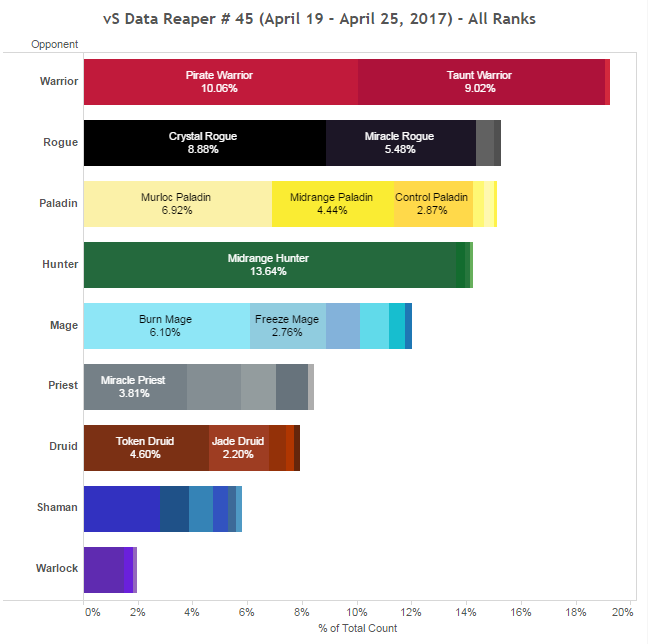

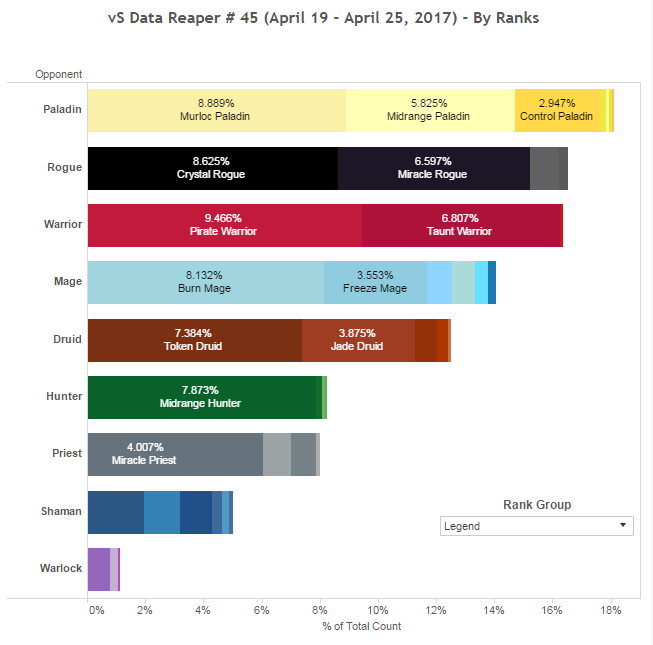


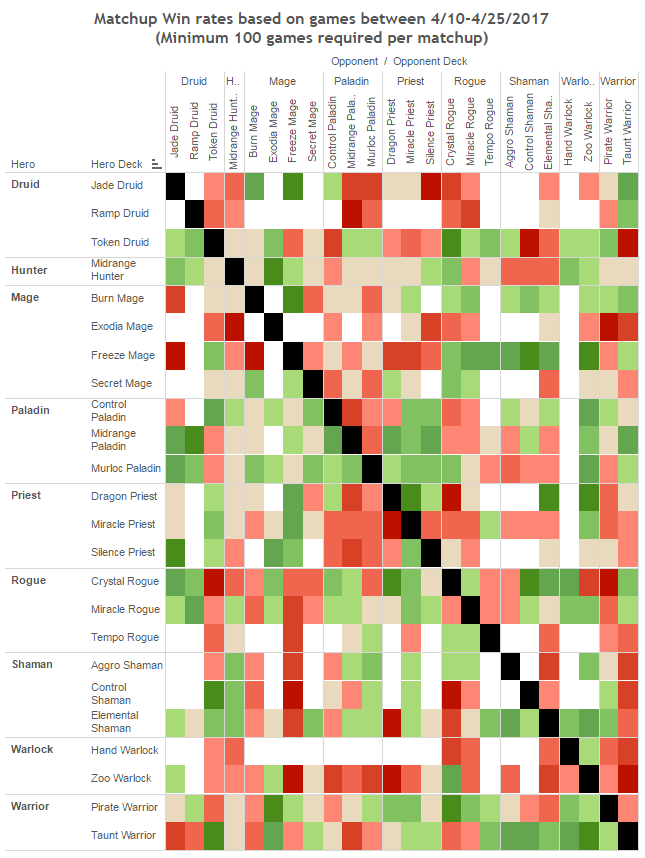
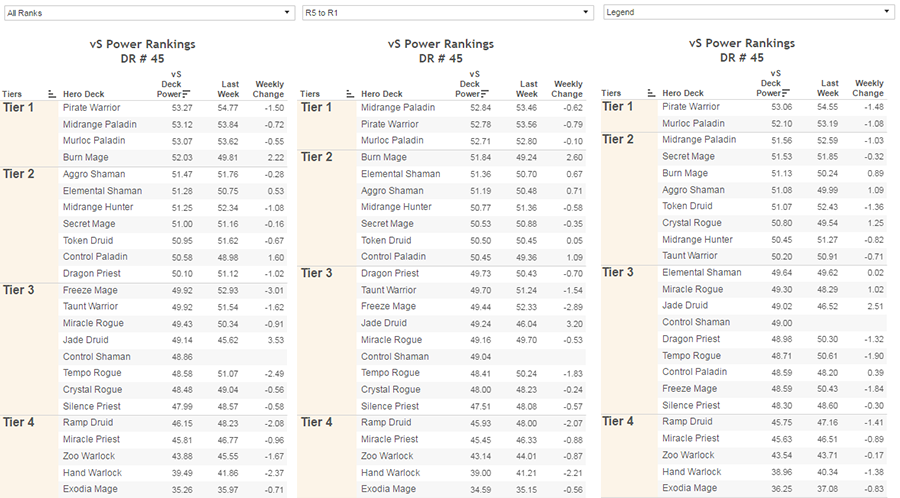


















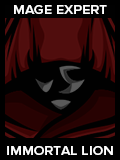




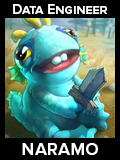

Hi guys, u are forget to out Strifecro’s elemental shaman, which is reach rank 3 legend on NA server
to add*
Just saying that I decided to become a supporter! I have an analytical mind and you guys not only give great charts, but a great breakdown that explains them.
Took advantage of your “Meta Breaker of the Week” several times to run up the ranks.
Thanks!
Thanks very much Logan! We are happy to hear that you enjoy our content.
Cassia’s Totem Shaman doesn’t seem to have any Un’goro cards. It’s surprising to see an old deck perform well in a new meta.
Where is warlock expert in contributors?
in vacation of hearthstone
Just wanted to say you guys are awesome. The Meta reports really showcase your ability to not only analyze, but also make sense and interpret the data brilliantly.
Hope you all make tons of money from this 🙂